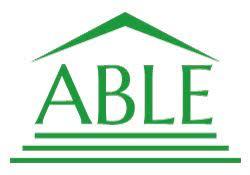
The Basics of ABLE Accounts
The Basics of ABLE Accounts
ABLE stands for Achieving a Better Life Experience. ABLE accounts were created via federal
legislation commonly known as The ABLE Act, which was passed in 2014. The first ABLE
accounts were established and funded in 2016.
Individuals with disabilities often qualify for public benefits (like Social Security, SNAP, and
Medicaid), and qualifying for these benefits typically requires individuals to have less than
$2,000 in their name. The new law supporting ABLE accounts acknowledges that living with a
disability frequently comes with extra and sometimes significant costs, and that owning assets
(like an investment account) that might be used to offset those costs should not be used
against an individual who otherwise qualifies for state or federal benefits.
ABLE accounts are only available to individuals who had an onset of a disability prior to age 26.
Individuals do not have to be under age 26 to have an ABLE account, but the disability’s onset
must have occurred prior to that age.
The disabled individual is both the owner and the beneficiary of the account, and only one ABLE
account can be held per individual. The income or gains earned inside the account are not
taxed. The accounts are state-sponsored and are currently offered by over 40 states. Individuals
do not have to use the ABLE program offered in their state, as most programs are open to both
residents and non-residents.
Contributions must be made with post-tax dollars, and there is no federal deduction for
contributions. Some states offer state tax deductions for contributions, but Massachusetts is
not one of them.
Generally, contributions received into an ABLE account, regardless of the (non-beneficiary)
donor, are limited to $15,000 per year. However, ABLE account owners who earn their own
income may exceed the $15,000 contribution limit, up to an additional $12,140 of their gross
income. Once an account exceeds $100,000 in value, the beneficiary’s SSI benefit will be
suspended.
Distributions can be used to pay for “qualified disability-related expenses.” These are typically
expenses related to housing, education, health care, transportation, assistive technology,
personal support, financial management, or administrative support.
If the beneficiary had been on Medicaid, upon the beneficiary’s death the state in which he or
she lived may file a claim against the account for the amount that the state spent on Medicaid
for the beneficiary, dating back to the time that the account was opened. Some states have
passed laws prohibiting this Medicaid payback provision. Otherwise, upon the account owner’s
death the account may be used for any outstanding qualified expenses (which may include
funeral and burial expenses) and any remaining funds will then be passed the named
beneficiary on the account.
When opening an account, questions to consider include:
• Setup and contributions: What documentation will the program require to establish an
account? Will there be a state tax deduction for any contributions to the account?
• Fees: Are there initial, minimum, or ongoing fees to open or maintain an account?
• Investments: What investment options are available, and at what underlying cost?
• Disbursements: What documentation does the program require in order to receive a
disbursement from the account? Are there restrictions on how often disbursements can be
made? Is there a companion checking account or debit card feature available?
Some ABLE programs worth considering:
• Ohio: the country’s first, largest, and most used ABLE program; pooled investment choices
through Vanguard, at an underlying cost of 0.45%-0.59% for non-residents; payroll
deduction and direct deposit; loadable debit card; $30 per year annual fee
• Massachusetts: pooled investment choices through Fidelity, with underlying costs of 0.57%
to 0.94%; no annual fee; debit card option when a companion Fidelity Cash Management
account (which could be held jointly with another person) is opened; ATM fee
reimbursement and free check writing
• Virginia: pooled investment choices via Vanguard and Fidelity, with underlying costs of
0.37% to 0.40%; annual fee of $39 per year, though waived with an average daily balance of
$10,000; no-cost debit card for the account itself (i.e., no need to open a separate checking
account)
• Illinois: pooled investment choices using Vanguard, Schwab, BlackRock and Sallie Mae
funds; underlying investment fees of 0.34% to 0.37%; $45 annual fee; no minimum acct
balances; debit card available with a Fifth Third Bank checking account
For more information, visit the web site for the ABLE National Resource Center at
www.ablenrc.org.
